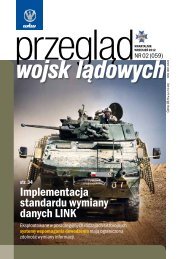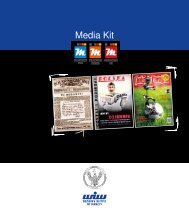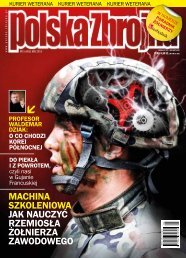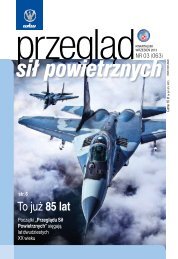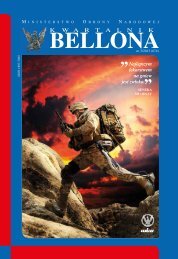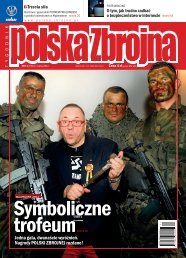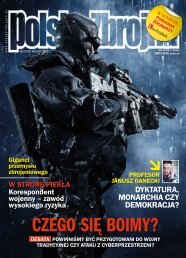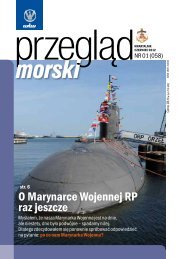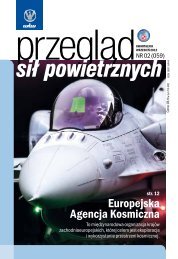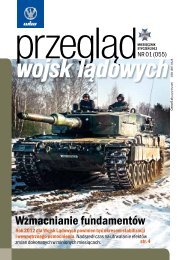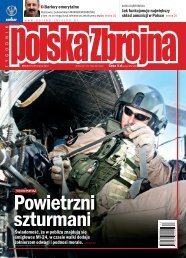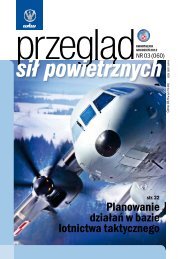Pobierz - Ministerstwo Obrony Narodowej
Pobierz - Ministerstwo Obrony Narodowej
Pobierz - Ministerstwo Obrony Narodowej
You also want an ePaper? Increase the reach of your titles
YUMPU automatically turns print PDFs into web optimized ePapers that Google loves.
Przegląd Wojsk Lądowych (The Land Forces Review)<br />
Dear Readers,<br />
the opening article this month is on recreating combat capability of troops<br />
which were part of the Polish Military Contingents and returned home after<br />
completing their tasks. The article indicates that there is no proper recreation<br />
system, and suggests that a certain scenario be introduced which would<br />
include trainings divided into phases, and which commanders would<br />
implement after troops return home.<br />
Another article is a summary of last year’s training efforts of engineering<br />
troops. The author of this article also presents plans for this year as well as<br />
their needs as regards acquirement of new warfare means.<br />
Contamination detection system and anticipated changes are the subject of<br />
the next article. The writer analyzes the needs to improve the existing system<br />
to meet the standards of future battlefield. The most important is to make a circulation of data on<br />
contamination situation a fully automated system.<br />
The following material deals with the issue of improving interoperability after Afghanistan operation is<br />
completed. There is a plan to build global training programs which would use efforts and resources to<br />
the best possible degree, but also satisfy training needs of all NATO armies. Key features of the above<br />
programs would be clearly defined needs as regards using NATO training when it is most required.<br />
The author of the next article writes about battalion combat groups and their proper performance during<br />
planned attack in direct encounter with an enemy. He particularly focuses on troops moving in enemy’s<br />
barrages set before the front end of defense line.<br />
The next writer suggests, based on his own experience, that in the decision-making process – particularly<br />
in the phase of task-setting – the following documents be used: FM 5-0 Army Planning and Orders<br />
Production and FM 3-0 Operations.<br />
Another author writes about building fortifications during preparation for and conduct of defense activities,<br />
and proves that this task has been, still is and will be a vital engineering element for force protection.<br />
Last but not least, there is also an article on upgrading maps and NATO requirements in that matter.<br />
We hope that our readers will find the remaining articles equally interesting.<br />
Enjoy reading!<br />
Editorial Staff<br />
Tłumaczenie: Anita Kwaterowska<br />
Warunki zamieszczania prac<br />
Materiały (w wersji elektronicznej) do „Przeglądu Wojsk Lądowych” prosimy przesyłać na adres: Wojskowy Instytut Wydawniczy,<br />
Aleje Jerozolimskie 97, 00-909 Warszawa lub przeglad-sz@zbrojni.pl. Opracowanie musi być podpisane imieniem i nazwiskiem<br />
z podaniem stopnia wojskowego i tytułu naukowego. Należy również podać numery: NIP, PESEL, dowodu osobistego oraz konta<br />
bankowego, a także dokładny adres służbowy, prywatny i urzędu skarbowego oraz numer telefonu, datę i miejsce urodzenia, jak<br />
również imiona rodziców. Ponadto należy dołączyć zdjęcie z aktualnym stopniem wojskowym. W przypadku braku wymaganych<br />
danych nie będziemy mogli opublikować danego materiału. Instytut przyjmuje materiały opracowane w formie artykułów. Ich<br />
objętość powinna wynosić ok. 13 tys. znaków (co odpowiada 4 stronom kwartalnika). Rysunki i szkice należy przygotować zgodnie<br />
z wymaganiami poligrafii (najlepiej w programie Ilustrator lub Corel), zdjęcia w formacie tiff lub jpeg – rozdzielczość 300 dpi.<br />
Należy podać źródła, z których autor korzystał przy opracowywaniu materiału. Niezamówionych artykułów Instytut nie zwraca.<br />
Zastrzega sobie przy tym prawo do dokonywania poprawek stylistycznych oraz skracania i uzupełniania artykułów bez naruszania<br />
myśli autora. Autorzy opublikowanych prac otrzymają honoraria według obowiązujących stawek. Oryginalne rysunki i zdjęcia<br />
zakwalifikowane do druku honoruje się oddzielnie.



